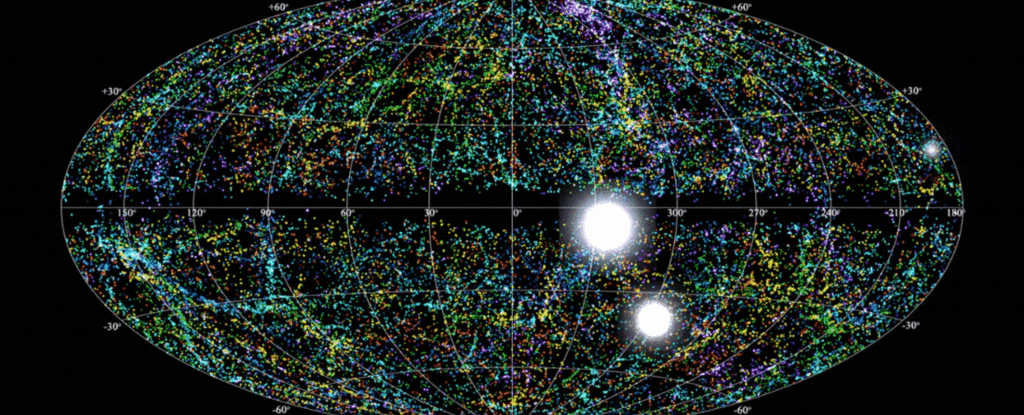
A mystery signal from the depths of the cosmos has just been caught doing something we've never seen before.
In the midst of the emission of a repeating fast radio burst, scientists have detected a drop in the center frequency of the signals over time – a drop that sounds, they say, like a cosmic slide-whistle when slowed down and played on a xylophone.
It's unclear exactly what this unique drop in frequency means, yet – aside from the fact that fast radio bursts continue to be weird, and to defy easy explanation.
"This work is exciting because it provides both confirmation of known FRB properties and the discovery of some new ones," says radio astronomer Sofia Sheikh of the SETI Institute.
"We're narrowing down the source of FRBs, for example, to extreme objects such as magnetars, but no existing model can explain all of the properties that have been observed so far."
Fast radio bursts, or FRBs, are very strange, but very nifty. As the name suggests, they're bursts of radio emission that are very fast: each burst lasts just a few microseconds to seconds.
They're really powerful, discharging in that short space of time as much energy as 500 million Suns. And they're a bit tricky to catch: most FRBs have only been caught flaring once, a strange, unpredictable spike in radio survey data.
That unpredictability and failure to repeat has made them difficult to study (although not impossible – great strides have been made in tracing and analyzing the one-off signals).
But a handful of FRB sources do something a bit different: they flare again and again, a strange staccato spatter of signals that sometimes follows a pattern, and sometimes doesn't.
These repeat sources are an opportunity to trace the source of an FRB with high precision, but also to plan for, and study in detail, signals from a single source.
This is what Sheikh and her colleagues have done, homing in on a source known as FRB 20220912A, coming from another galaxy around a billion light-years away.
They analyzed 541 hours of observation data from the Allen Telescope Array, and extracted a total of 35 bursts, with an average duration of 1.2 milliseconds.
They then stretched out these signals, and studied how the emission from the source changes over time. There were some characteristics that the FRB 20220912A bursts shared in common with other FRBs, such as a downward frequency drift, a link between the signal bandwidth and center frequency, and changes in burst duration over time.
The researchers looked for patterns in the propagation of the bursts, and found none. FRB 20220912A appears to be one of the repeaters that does so at random. But the signals it spits out are pretty interesting.
Over the two months the bursts were scattered, the researchers also noticed a drop in the center frequency of the bursts. Here's what that sounds like, when the data is translated into musical notes on a xylophone.
What we don't know is why this drop occurs, but it could be information that helps scientists figure out where FRBs are coming from.
Evidence suggests that at least some FRBs are emitted by magnetars, but we don't yet know if that's the case for all FRBs, or if there's a different magnetar behavior behind different types of FRBs. Although we're getting closer to answers, we're far from a comprehensive description of how these signals are created.
Finding strange behaviors brings us closer, even when we can't quite explain them yet. None of the behavior noted in FRB 20220912A favor or rule out any models of FRB creation and propagation, but it does provide a benchmark against which future observations can be compared, the researchers say.
The discovery also highlights the importance of instruments such as the Allen Telescope Array, which has the ability to record a wide range of bandwidths as it studies the sky. This reveals behaviors that might not be picked up by instruments that have a narrower focus.
"More observations of the source," the researchers write, "especially at higher frequencies with instruments like the ATA, will help to differentiate between the various classes of FRB progenitor models."
The team's paper has been accepted for publication in the Monthly Notices of the Royal Astronomical Society, and is available on preprint server arXiv.
Bizarre Fast Radio Burst Exhibits a Unique Signal Never Seen Before - ScienceAlert
Read More
No comments:
Post a Comment